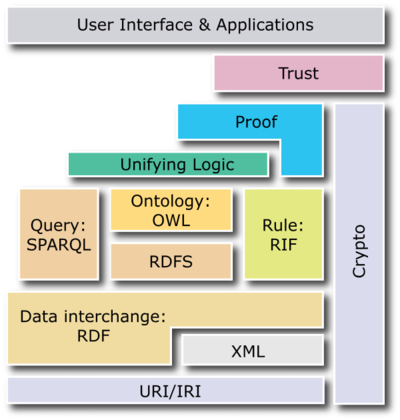Draft one
From DigitalRhetoricCollaborative
Contents |
[edit] Overview
The semantic web is a concept and potential Internet framework proposed by the W3C. The system would be a “web of data” as opposed to the “web of documents” that Web 2.0 currently supports. This web of data would allow computers to complete a wider array of tasks, similar to the power that a single computer can do with access to a database.[1]
The current Internet framework is designed with the user experience in mind, but the semantic web would be arranged in a manner that befit computers. The Internet would garner qualities akin to a database, but still remain decentralized. By using standardized and efficient markup languages and ontologies, which in computer science denote the formal relationship between terms, computers could process the relationships between data.[2]
[edit] History
The semantic web was conceptualized for the public in a 2001 article in the Scientific American. The article was written by Tim Berners-Lee, James Hendler, and Ora Lassila. The article explained scenarios in which the technology could help and outlined the reasons why the semantic web should be the next step forward for the Internet, citing an expansion of collective knowledge, organization, and a couple small examples of its use on a personal level.[3]
While the semantic web outlined in this article has not yet been realized, small examples of semantic web technology have emerged. In 2010, Google acquired open database company Metaweb and began to publicly operate Freebase, a community controlled database of all things in the world.[4] In 2015, Freebase became read only and its ongoing database was combined with Wikidata.[5] Google’s Knowledge Graph also allows Google searches to find immediate facts instead of just web links.
Apple’s Siri, released in 2011 with the iPhone 4S, is an example of a semantic web agent.[6] The mobile program pulls data from a user’s calendar, location, and Internet search results to answer questions, book reservations, and organize a schedule. While Siri’s abilities do not fully encompass the ideas of the semantic web, the program loosely matches the agent description in Berners-Lee’s semantic web proposal.
[edit] Technical Structure
This system of linked data could be supported by the Resource Description Framework (RDF), the SPARQL Protocol and RDF Query Language (SPARQL), Web Ontology Language (OWL), and the Simple Knowledge Organization System (SKOS).
RDF handles Internet data interchange and could prove useful for the semantic web in its “triples” capability. Triples use uniform resource identifiers (URI) to both identify two ends of a link and define relationships between data, creating a “node-arc-node” system.[7]
SPARQL is a query language for RDF. SPARQL can also use triples, called basic graph patterns, only that the nodes and arcs of the triple in SPARQL can be variables. SPARQL then matches this basic graph pattern to standardized RDF triples.[8]
OWL gives ontologies on the Web formally defined meaning. It is can used alongside RDF data. OWL defines the relationships between ontology structures and RDF graphs through mapping. XML is often used to process OWL relationships.[9]
SKOS allows for the expression of controlled vocabulary in concept schemes. A concept scheme allows for data to be grouped in a standardized manner, and SKOS would allow the semantic web’s computers to tap into user generated concept schemes to retrieve hyperrelevant information on queries.[10]
[edit] Obstacles
The semantic web requires a great deal of cooperation from businesses to reach its full potential, being that open APIs will become greatly important. Tech writer Stephen Downes notes that getting businesses to agree to aid each other with open APIs of their technology could be difficult to make appealing from a business sense, and it would require standardization across companies.[11]
Researcher Yinghui Wu notes that the current complexity of semantic web technologies creates a barrier to entry for many engineers and programmers who otherwise could be a great boon to the project. While RDF is a common feature, SPARQL and OWL are not as widely used.[12]
In 2006, Tim Berners-Lee, Nigel Shadbolt, and Wendy Hall published “The Semantic Web Revisited”. The paper refutes accusations that the semantic web has “failed to deliver”, instead just possessing the tools and agents needed but not the complete standardization to come into actuality. The growing use of ontologies is cited as evidence of progress.[13]
[edit] External Links
The Semantic Web Wikipedia Article
Further W3C Information on Linked Data
[edit] References
- ↑ http://www.w3.org/standards/semanticweb/
- ↑ http://www.w3.org/2001/sw/SW-FAQ
- ↑ http://www.cs.umd.edu/~golbeck/LBSC690/SemanticWeb.html
- ↑ http://googleblog.blogspot.com/2010/07/deeper-understanding-with-metaweb.html
- ↑ http://searchengineland.com/google-close-freebase-helped-feed-knowledge-graph-211103
- ↑ http://www.apple.com/pr/library/2011/10/04Apple-Launches-iPhone-4S-iOS-5-iCloud.html
- ↑ http://www.w3.org/TR/rdf11-concepts/#section-Introduction
- ↑ http://www.w3.org/TR/rdf-sparql-query/
- ↑ http://www.w3.org/TR/owl2-overview/
- ↑ http://www.w3.org/2004/02/skos/
- ↑ http://halfanhour.blogspot.com/2007/03/why-semantic-web-will-fail.html
- ↑ https://murroesyinghui.wordpress.com/2012/04/16/critique-of-semantic-web-technologies-or-why-it-might-not-work-in-emerging-application/
- ↑ http://eprints.soton.ac.uk/262614/1/Semantic_Web_Revisted.pdf


